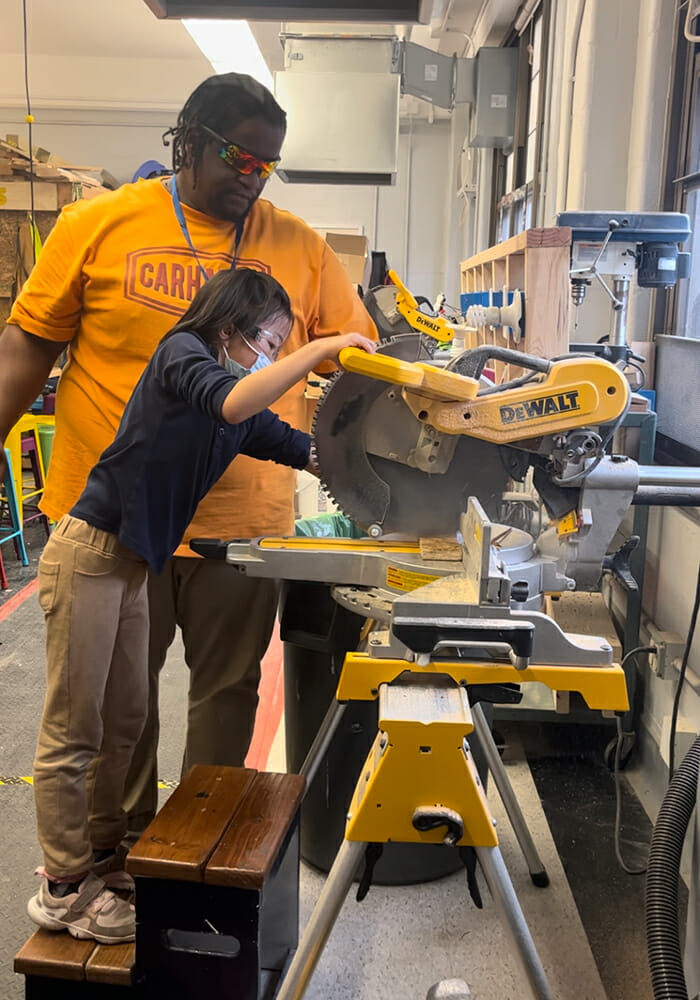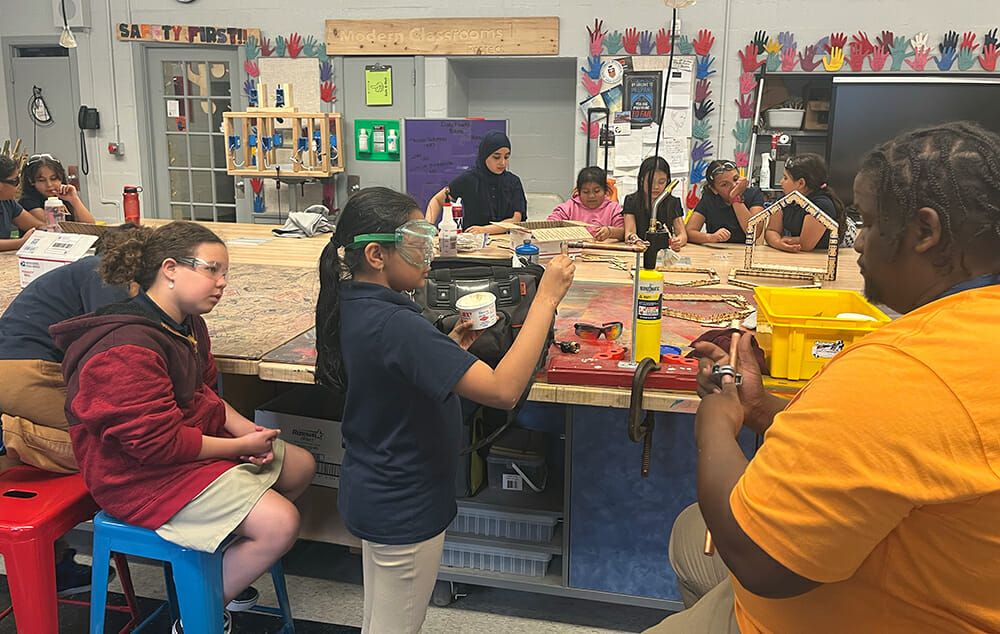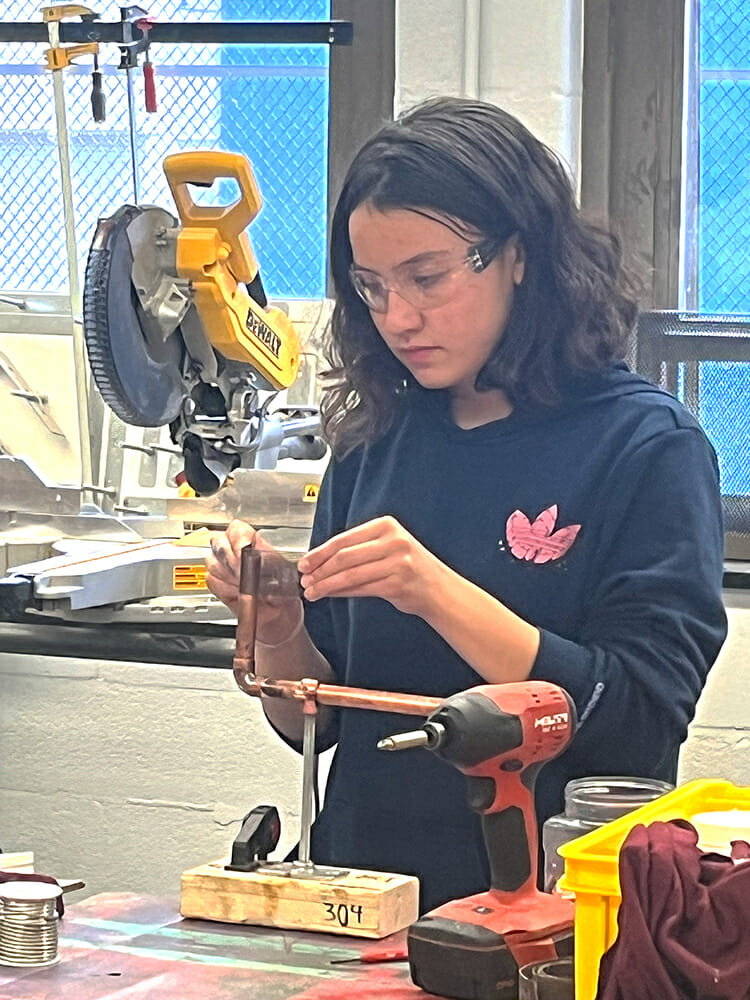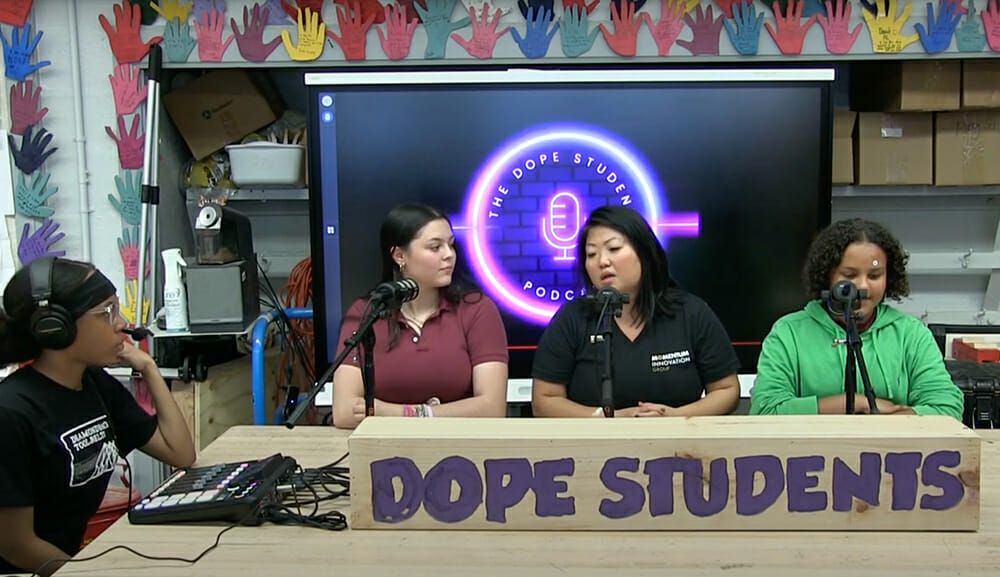The Cost of a Dated Education System to Our Workforce

Heather Wallace is Director of Communications / Project Manager at Momentum Innovations Group
It’s 5:30 in the morning at Mayfair School and Evin Jarrett is in his classroom preparing for the students who will begin trickling into his room around 6 am. This marks the beginning of his normal 12-hour day as he provides a place of refuge for students who are home alone early in the morning or after school.
Throughout the day there is constant knocking on his door - kids just dropping by to say “Hi”, to give him a hug, or begging him to let them hang out in his classroom. Some of them are skipping lunch and some are trying to skip other classes to be there, but one thing is very clear…kids desperately want to be in Mr. Jarrett’s middle school construction trades class.
His phenomenal hands-on learning experience serves 4th through 8th graders in a Title 1 school in Philadelphia. Once Evin feels a class has a solid understanding of safety, they are able to move on to learning to use power tools, basic plumbing (including sweating pipes) and electrical, masonry, framing, as well as introductions to technology and offsite construction.
One of the ways Evin is able to do so much hands-on learning in his classroom is by making theory the homework. Much of his success, however, comes from his ability to be flexible, as well as the relationships he has built with his students. He understands that each student’s home life plays a huge factor in their success. Those who do not have access to the internet at home aren’t penalized for not getting homework completed on time.
It is the only middle school program I’ve come across like this in the nation. And Mr. Jarrett is one of those special teachers. He understands the tremendous time commitment necessary for his program to be successful. And as a union member he doesn’t get paid more by showing up early or staying late.
“My students deserve my BEST at all times,” says Mr. Jarrett. “I don’t have the luxury of having bad days. I’m trying to change lives.”

Students learn to safely use power tools in Mr. Jarrett’s class. (Photo: Heather Wallace)
Challenges in Public Education
As the construction industry continues to look for successful strategies to entice young workers to join, Mr. Jarrett’s class both emphasizes the benefits of careers in construction trades and also puts a spotlight on the huge challenges we have in the public education system.
Teaching in settings with large class sizes will always be a challenge, but Evin has an additional language barrier. Mayfair School is home to students who speak Spanish, Portuguese, Arabic, Vietnamese, Russian, French, Mandarin, and Khmer and sometimes there are 4-5 different languages being spoken in his class at one time.
Many of these students do not speak English so he has had to find innovative ways to translate safety and lesson plans into multiple languages. His two most common methods are utilizing students who are fluent, as translators; and AI bot recordings that translate his material into a required language.
And then there’s standardized testing. Overall, non-English speaking students do poorly on these tests for very obvious reasons. In Mr. Jarrett’s class they may also take a mock-NOCTI exam as an 8th grader. NOCTI provides credentialing tools to support Pennsylvania’s career and technical education (CTE) programs. Half of the test is hands-on and allows a person to demonstrate skills and technical knowledge; the other half is a written test - currently only available in English and normally given to Junior or Seniors in high school.
For Evin’s students who want a career in the construction trades, the transition from middle school to high school is rough and oftentimes disappointing. Like most public schools, Mayfair students must apply to their preferred high school and are put into a lottery system that determines the order in which students get to choose. Only a few high schools in the district offer construction CTE programs.
Emelyn, one of Evin’s star students, dreams of becoming a construction trades teacher. She has passed his mock-NOCTI exam but was not able to get into Swenson Arts and Technology High School. “I’m pretty frustrated,” says Emelyn. “They have a carpentry program and I wanted to continue the trades in the future. I know plumbing, electrical and carpentry - this is a very big disappointment.”
Evin’s school district initially promised that his top students would receive exceptions from the lottery and would be able to get into the high school trade program of their choice. But this has not panned out for students like Emelyn. For Evin’s program to be able to provide a meaningful pathway to construction, it will require the school administration and district to be 100% onboard and support him.
To date, the exceptions have not been approved and there is no solution for his students.
More Than Trades
Ask any employer what young people are lacking as they enter the workforce and “soft skills” is at the top of the list. Being comfortable with failure is one of the pillars for building soft skills.
Evin has successfully created a safe culture for failing forward in his classroom. His students - both the loud ones and the quiet ones - are eager to raise their hands hoping to provide a correct answer and have the opportunity to demonstrate part of their hands-on activity. And they are not deterred by a wrong answer - they simply raise their hand again.
His students are also encouraged and empowered to lead. In addition to assisting with lesson translations, his students also help with photography and run The Dope Student Podcast where they interview guests (using questions they write themselves) and oversee sound, podcast equipment and video cameras. This year Mr. Jarrett started working with Momentum Innovation Group to help test out offsite construction curriculum. Students built WikiHouse models and one student is now creating a “how-to” WikiHouse training video to help students better understand how to put it together.

At times there are 4-5 different languages represented in Mr. Jarrett’s class at one time. (Photo: Heather Wallace)

Emelyn working on a plumbing project. (Photo: Heather Wallace)
Related Listening:
From Stress Comes Strength: Developing the Construction Workforce of Tomorrow w/ Kevin O'Connor, Host of This Old House
Kevin O'Connor, longtime host of the Emmy Award-winning series This Old House, joins the podcast to share his perspective on the benefits of offsite construction practices in residential construction.
Kevin also talks about This Old House's Generation NEXT initiative, the construction industry's worker shortage, and how professionals within the industry can encourage young students and recent graduates to enter (and excel in) the trades.
What is the Role of Industry?
When the subject of workforce development arises there are many opinions on how our dwindling labor pool has become what it is. There is likely some truth to everyone’s response, but the real question should be: How do we help fix this mess? The reality of our labor shortage is that it’s our problem and each of us can play a part in helping to fix it. Kids need early exposure to the offsite construction industry.
On a positive note, there are a lot of people and organizations working on solutions. But industry has to be authentically involved. If your business is near schools, reach out to them and offer to send your kid-friendly employee to do an in-person presentation to elementary or middle school students about what your company does in the offsite construction space. Or create an engaging pre-recorded version that educators across the country can use in career exploration classes. Offer tours of your facility. Teach them about the exciting careers available in our industry. Unless they see these jobs they will never consider them as a career.

Students in Evin Jarrett’s construction trades CTE program run The Dope Student Podcast where they regularly interview industry professionals. (Photo: Evin Jarrett)
How Does Education Need to Change?
Primary and secondary education need to adapt to infuse career exploration and development with core curriculum. Every student should have the opportunity to learn about engineering or home economics while learning math. Let them learn about HVAC systems in science class. Have them explore social issues by learning about the construction industry and how housing shortages impact society.
Let’s take the focus away from what 4-year school they are going to and instead start asking them early on: How do you want to change the world? Education should act as building blocks to get them to the place where they can dream big and become problem solvers of the future. But for students like Emelyn, this has not been her experience. For two years she was forced to take Spanish classes - she was already fluent in Spanish. She could have spent that time in Evin’s classroom as a teaching assistant - a far better fit and use of her time and it builds on what she’s passionate about.
The Carnegie Foundation for the Advancement of Teaching - the same organization that designed our current grading system - is exploring how to update our grading system to provide students credit and acknowledgement for activities like working full-time during high school. For this to work, schools and industry will also have to shift their thinking and redefine what success looks like and what it really means.
More from Modular Advantage
Resia: Breaking All the Rules
Resia Manufacturing, a division of U.S.-based Resia, is now offering prefabricated bathroom and kitchen components to industry partners. Its hybrid fabrication facility produces more precise bathroom and kitchen components (modules) faster and at lower cost than traditional construction. Here’s how Resia Manufacturing does it.
How LINQ Modular Innovates to Bring Modular To The Market in the UAE and Beyond
LINQ Modular, with an office and three manufacturing facilities in Dubai, is a modular firm based in United Arab Emirates. The company is on a mission: to break open the housing and construction markets in the Gulf Cooperation Council (GCC) area with modular.
ModMax: Redefining Modular Construction with Confidence and Precision
ModMax was born out of frustration—frustration with five persistent pain points in modular construction: Permitting bottlenecks. Production delays. Rigid designs. Disconnect between “the office” and the field. Lack of transparency and communication.
LifeArk: Disaster-Resilient Housing from Recycled Plastic and 100-year-old Technology
Wee compares LifeArk’s housing units to Yeti coolers, as they are built similarly. Each component takes 15 to 20 minutes to manufacture, has an R-value of 40, and includes molded slots and chases for wiring, plumbing, fire sprinklers, and other utilities.
Building the Future of Modular Edge Infrastructure
The edge data center market is expanding rapidly, driven by the surge in AI workloads, IoT adoption, and the need for localized compute power. In these environments, sustainability, scalability, and reliability are non-negotiable. Cooling is among the most complex challenges for operators—and one of the most decisive factors in long-term success.
Accelerating Light-Gauge Steel Construction: A Semi-Automated Digital Workflow for Off-Site Projects
For construction professionals, the message is clear. By adopting semi-automation and digitalization, companies can deliver projects faster, more accurately, and more profitably, while also building stronger collaboration across teams. The approach is not about replacing people with machines, but about empowering people with better tools and processes.
Why Modular Data Centers Are Gaining Momentum
Artificial intelligence, high-performance computing, and edge applications push the limits of traditional “stick-built” data centers. They take years build, often struggle with high density workloads, and aren’t optimized for deployments near end users. Modular data center platforms are purpose-built to address these challenges, offering flexibility and scalability to adapt to evolving technologies, while opening new opportunities for the modular construction industry.
Supply Chain Innovation in Action: 5 Habits Every Modular Leader Should Practice
By applying these principles to supply chain practices — collaborative planning, strategic procurement, scenario modeling, digital tools, and transparent forecasting — construction leaders can build value chains that are not just efficient and agile, but truly innovative.
Exploring the Role of Modular Integrated Construction (MiC) in Advancing Circular City Principles – A Survey of Stakeholder Perspectives
The survey findings highlight the significant potential of Modular integrated Construction (MiC) in advancing the development of circular cities. By reducing costs, accelerating construction timelines, and minimizing waste generation, MiC offers a promising approach to sustainable urban development.
The Use of MS POLYMER™-Based Sealants and Adhesives in Modular Building
These products combine flexibility and elastic recovery with excellent adhesion to different substrates and have already shown their usefulness in traditional construction. Now it’s time for them to be put to use in the modular construction industry.










